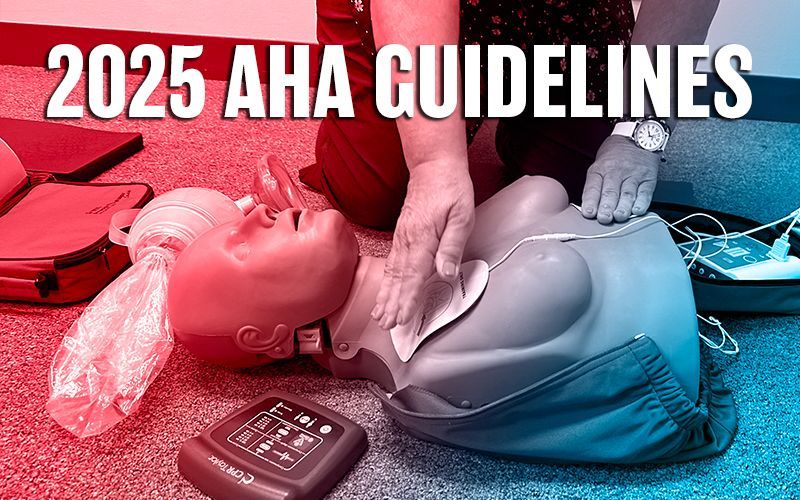2025 AHA CPR & ECC Guidelines: Key Updates, Insights, and Implications for the Future of Resuscitation Training
Every five years, the release of new American Heart Association (AHA) Guidelines for Cardiopulmonary Resuscitation (CPR) and Emergency Cardiovascular Care (ECC) sets the global standard for how lifesaving education and care are delivered. The 2025 Guidelines, developed in collaboration with the International Liaison Committee on Resuscitation (ILCOR), represent one of the most comprehensive evolutions in resuscitation science since the program’s inception.
These updates extend far beyond algorithmic changes, they reimagine how we prevent, recognize, and respond to cardiac arrest across entire systems of care. The 2025 Guidelines are grounded in the understanding that outcomes are determined not just by what rescuers do in a moment of crisis, but by how consistently teams, communities, and educators train to prepare for those moments.
For healthcare educators, instructors, and training organizations, this is a pivotal moment. The 2025 updates prioritize quality improvement, equitable access, and data-driven training, ensuring that every provider and every lay rescuer has the knowledge and tools to make a measurable impact.
For more than 30 years, WorldPoint has partnered with the resuscitation and healthcare education community to strengthen that mission. We’re proud to help instructors and organizations worldwide deliver effective, evidence-based training that saves lives.
The Big Picture: What’s New and Why It Matters
The 2025 Guidelines are structured around the Utstein Formula for Survival a model that defines the key components of successful resuscitation:
- High-quality science and evidence-based guidelines
- Effective education and skill acquisition
- Strong local systems of care and implementation
Together, these create a sustainable foundation for improving survival and neurological outcomes.
A Unified Approach to the Chain of Survival
The AHA now presents a single six-link Chain of Survival that applies across adults, pediatrics, and in-hospital and out-of-hospital settings. This standardization simplifies training, reinforces consistent terminology, and highlights a shared set of lifesaving actions: early recognition, early CPR, rapid defibrillation, advanced care, and post-arrest recovery.
For the first time, the AHA also introduces a seven-link Newborn Chain of Care, addressing the continuum from prenatal preparation to postnatal stabilization. This addition recognizes that optimal neonatal outcomes depend on seamless transitions of care, family-centered support, and prevention strategies before birth.
Systems of Care, Equity, and Implementation
A defining theme of the 2025 Guidelines is systems-based performance improvement. Survival now depends as much on coordination as on individual skill. Updated recommendations highlight:
- Telecommunicator CPR (Class 1, LOE A): dispatchers play a pivotal role in early recognition and compression guidance.
- On-scene resuscitation for out-of-hospital cardiac arrest (Class 2a, LOE B-NR), reducing the risks of premature transport.
- Public access to naloxone and bystander response programs to address the opioid crisis.
- Early warning systems and safety huddles to prevent in-hospital cardiac arrest.
- Expanded focus on health equity, calling for CPR and AED training in underserved and high-risk communities.
Education, Training, and Technology
The Resuscitation Education Science section has been significantly expanded. The AHA now assigns a Class 1 (LOE A) recommendation for feedback devices in both professional and lay training environments, recognizing their ability to improve skill retention and performance quality.
Innovative methods like gamification, rapid-cycle deliberate practice, and scripted debriefing are supported (Class 2b), while virtual reality (VR) is encouraged for cognitive learning (Class 2b) but not for hands-on CPR skills (Class 3 – Harm). Augmented reality (AR) may be used for real-time feedback (Class 2b).
A Broader Lens on Ethics and Well-Being
The 2025 Guidelines include expanded discussions on ethical decision-making, equity in resuscitation access, and for the first time, clinician well-being. Burnout mitigation strategies are now formally recognized as part of post–cardiac arrest systems of care (Class 2b).
Side-by-Side Comparison: 2020 vs. 2025 AHA CPR & ECC Guidelines
| Category | 2020 Guidelines (Baseline) | 2025 Guidelines (Update) |
| Framework & Terminology |
|
|
| Systems of Care (SOC) |
|
|
| Neonatal Resuscitation |
|
|
| Pediatric Basic Life Support (PBLS) |
|
|
| Adult Basic Life Support (BLS) |
|
|
| Pediatric Advanced Life Support (PALS) |
|
|
| Adult Advanced Life Support (ALS) |
|
|
| Special Circumstances |
|
|
| Post-Cardiac Arrest Care |
|
|
| Resuscitation Education Science |
|
|
Why It Matters
The 2025 Guidelines reinforce that resuscitation is a system, not a single act. Every update—whether to algorithms, education, or ethics—reflects a deeper shift toward measurable performance and equitable access.
For educators and healthcare leaders, this means:
- Investing in feedback-capable training technology that aligns with Class 1 evidence for improving skill quality.
- Expanding community and school-based CPR programs to reach undertrained populations.
- Building integrated systems of care that connect dispatchers, responders, hospitals, and survivors.
- Supporting instructor development and debriefing culture that sustain quality improvement.
For over three decades, WorldPoint has stood alongside the resuscitation community as a trusted partner—helping instructors, educators, and institutions deliver high-quality, evidence-based training. As the science advances, we remain committed to helping our industry adapt, align, and thrive, empowering educators to prepare the next generation of lifesavers.
Conclusion
The 2025 AHA CPR & ECC Guidelines mark a new era in resuscitation, one that connects science, systems, and education into a unified vision for survival. By embracing these updates, healthcare and training leaders can ensure that lifesaving interventions are delivered consistently, effectively, and equitably.
At WorldPoint, we share the AHA’s commitment to improving outcomes from sudden cardiac arrest through education, preparation, and partnership. For more than 30 years, we have equipped those who teach others to save lives. And as these new guidelines take hold, we stand ready to continue that mission, helping instructors and organizations around the world implement the science that saves lives.
References
- American Heart Association. 2025 AHA Guidelines for Cardiopulmonary Resuscitation and Emergency Cardiovascular Care – Executive Summary. Published October 2025 in Circulation. https://cpr.heart.org/en/resuscitation-science/cpr-and-ecc-guidelines/executive-summary
- American Heart Association. CPR & ECC Guidelines Portal. Accessed October 2025. https://cpr.heart.org/en/resuscitation-science/cpr-and-ecc-guidelines


